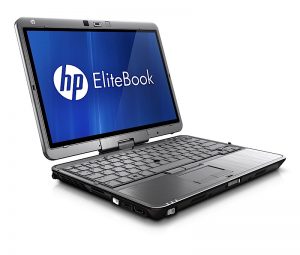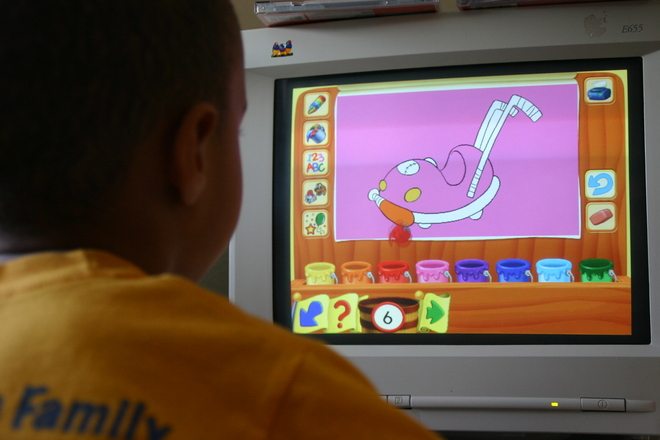 This is a follow-up guest post by Joanne C. Simpson:
This is a follow-up guest post by Joanne C. Simpson:
Baltimore County Public Schools plans to expand its tech initiative, despite an apparent lack of funding — short- and long-term — as well as pointed criticism from some Board of Education members, and downward trending standardized test scores in so-called “lighthouse” schools with the one-laptop-per-student program.
The controversial digital conversion is currently slated for all county schools grades 1 through 6, as well as three pilot high schools in September. That rollout is pared back from previous plans, which included laptops at least middle school-wide.
Still, the long-discussed program cost of $205 million might be closer to $350 million — just in the first six years, according to pending contracts and other sources. And taxpayers would be on the hook for nearly $60 million in laptop leases each year, and more with software contract renewals and increasing tech expenses — in perpetuity.
Among other possible pending issues not widely known:
The school board on Tuesday is set to vote on another $41 million to fund laptop-linked interactive classroom projectors with average life spans of just five years.
The proposed 2016-17 budget would pull nearly $20 million from the school system’s surplus, though administrators haven’t detailed where the money would go. The gap in proposed funding for the digital initiative next year is $24 million.
[pullquote]”We are hook, line and sinker, absolutely bought and paid for by the technological-educational complex, and it’s almost scandalous. I’m hoping it never becomes a scandal.” School Board member Michael J. Collins [/pullquote]
A “locked-in” scenario for laptop leases recently described by the administration seems a marked reversal of the scenario of limited financial responsibility and numerous “outs” when the program was presented to the school board and public two years ago.
The school system might not need to expand the program much at all — despite a sense of inevitability in the
community and pressure from Superintendent S. Dallas Dance — because BCPS is in striking distance of meeting current lease obligations, and could slow the expansion or even end the overall contract, according to school officials and documents.
Some of the math, so far, seems to go like this:
The Board of Education authorized the school system to spend $205 million to lease up to 150,000 HP EliteBooks from Maryland vendor Daly Computers, a close affiliate of Hewlett-Packard. The contract was approved by the board in spring 2014, and the $1,400 laptop/tablets started showing up in classrooms in August that year.
 A copy of the Daly contract released to school board members on Friday indicates BCPS is only obligated to pay about $52 million total over the four-year master lease agreement for devices and related costs, such as carts and cases. A minimum obligation was set up in case the county could not find funding for the higher price tag.
A copy of the Daly contract released to school board members on Friday indicates BCPS is only obligated to pay about $52 million total over the four-year master lease agreement for devices and related costs, such as carts and cases. A minimum obligation was set up in case the county could not find funding for the higher price tag.
With payments already made, BCPS currently has an outstanding “obligation for about $31 million in leases that has to play out over a number of years,” BCPS Budget Director George Sarris told school board members at a Jan. 19 school board meeting. That could work out to $10 million or $15 million a year for the next couple years, until the end of the leases, various documents show.
That bill would not be so hard for the school system to meet.

Dallas Dance
Yet the proposed 2016-2017 school budget—set to be voted on at this Tuesday’s school board meeting (Feb. 2) —includes up to four times that amount, at $38 million next year. That’s in laptop leasing costs alone, with annual payments of about $60 million through 2021, according to budget planning documents.
(To share your thoughts with the members of the Board of Education prior to the Feb. 2 vote, you can call 443-809-4126 or find their email addresses here.)
The leases “are very, very shaky. We are clearly a victim in this system of the technological-educational complex,” said school board member Michael J. Collins at the Jan. 19 school board meeting. “We are hook, line and sinker, absolutely bought and paid for by the technological-educational complex, and it’s almost scandalous. I’m hoping it never becomes a scandal.”

Michael Collins
As part of the proposed budget, the school system is asking the county to pick up $14.5 million in added leasing costs for the devices linked to the tech expansion. School administrators have repeatedly said the $14.5 million would go directly to the schools’ “digital conversion,” otherwise known as Students and Teachers Accessing Tomorrow (STAT). If approved by the board, BCPS’ proposed $1.5 billion budget is then sent to Baltimore County Executive Kevin Kamenetz and the Baltimore County Council for consideration.
Various questions about the ins-and-outs of STAT went unanswered by Superintendent Dance over the past two weeks. Dance, who has enthusiastically spearheaded the digital initiative, has said he favors the integrative use of technology, even though there is no independent proof yet of long-term positive learning outcomes. “We know there’s no research out there that shows that giving a kid a device will improve his test score,” Dance has said, adding, in a broad leap of faith: “But getting kids more engaged in their learning will increase test scores.”
In terms of the upcoming budget, Dance did note a total of 168 STAT teachers who aid classroom teachers with the new technologies across the county, a boon to the initiative. Still unclear however: only $1 million is set aside for their salaries under the STAT budget, according to Sarris. That covers about 16 STAT teachers, with average annual salary/benefits costs of about $60,000, Dance noted.
The remaining 152 STAT teachers would then add about $9 million in annual costs to the “6-year digital conversion’s Grand Total Ongoing Cost” of $272 million—which also includes online or video curriculum, professional development, etc.
That virtual-oriented environment is now virtually $312 million.
Confused yet? Similar befuddlement over such numbers and rapidly rising tallies, especially with the budget vote slated for Feb. 2, led to an extensive debate at the Jan. 19 school board meeting and a flurry of emails during the blizzard this past week concerning the budget and future of STAT.
At the meeting, a few board members called for a one-year slowdown in the rollouts to better evaluate student outcomes and avoid signing new leases for thousands of devices. Currently, the laptop-per-student approach, also known as 1:1, is primarily used in 10 BCPS test schools, known as lighthouse schools (in 6th and kindergarten through 4th or 5th), and in all county elementary grades 1-3.
Collins and others expressed concerns about the 1:1 laptop approach on Jan. 19, yet also supported upgrades in technology in schools. (I expressed a similar view as a BCPS parent in comments before the board on Jan. 5).
Said Collins, who had opposed expanding beyond test schools so quickly: “I believe very strongly in technology in schools, but we don’t know how this is all working out. At all. And the info we are getting from the data so far is not good. We are just going awfully fast, and we are going to be spending a couple of billion dollars — that’s with a B — at least on this program in the next 5 to 10 years before we get adequate results.”
Other school board members agreed.

Ann Miller
“With so many needs in our school system, I think our spending is not aligned with correct priorities,” said board member Ann Miller, who moved to slow STAT’s device rollout pending “quantitative evidence of success,” and to spend the $14.5 million requested from the county on other priorities. She suggested redirecting the money to health and safety needs (which might include funding to ease overstretched bus routes), as well as hiring more teachers to help reduce class sizes. Many classes in the county are approaching 30 students. “We are in the process of overhauling our school system to accommodate STAT.”
Miller also noted that the program is an experiment, especially among larger school districts. (Some, mostly medium-sized or small school districts, have 1:1 programs primarily in high or middle schools, with the best outcomes in classes of 13 students or fewer, research shows. Overall, results have been mixed (“Seeing No Progress, Some Schools Drop Laptops”), with numerous school districts abandoning such programs mostly because of cost and logistics issues, and a lack of clear long-term improvements in student performance.)
“The deeper we go, the more stuck we will be if, when we get results, we find that they are not what we were expecting,” Miller added. “Our contractors will know we are stuck. What will prevent us from getting thoroughly hosed by our contractors at renewal? And will we be able to sustain this program in the future?”
There was no direct answer from the administration during the meeting. Miller’s motion later failed for lack of a majority vote.

Charles McDaniels
Even Board Chair Charles McDaniels, Jr., a staunch supporter of Dance, expressed misgivings: “Metrics [performance data] would allow us to keep track of the investment we have made, and I agree we don’t have that information,” he said. McDaniels cited increased use of tech in university courses and elsewhere. “I still think we as a county, we as a country are falling behind with our integration of tech in education. I also understand there’s a difference when you’re talking about a 20-year-old student and a 10-year-old student—there are concerns that exist.”
Added Collins: “I just wish we’d be a little wiser and more thoughtful before barging ahead and doing all this in hopes that it will work out.”
Superintendent Dance has slowed the program somewhat from the original plan, so far not expanding it to all kindergartens and middle school grades this upcoming year, partly because of concerns over how device use is playing out in those classrooms. The school system is moving toward pods, or carts, for laptops in kindergarten. Some successes so far have included an overall effectiveness of STAT teachers, mentors who work with classroom teachers to utilize online curriculum and devices, according to various sources. “Their knowledge and enthusiasm are evident,” Collins said.
Top among the problems: digital distraction.
Numerous sixth grade students have broken through “security blocks” to play video games and surf online during class, a problem Dance acknowledged and says he is working to address. This issue has plagued most laptop-per-student programs for years. Hoboken, N.J.’s school district abandoned (“Why a New Jersey school district decided giving laptops to students is a terrible idea” ) their laptop program in 2014, partly because of security and distraction issues. Hoboken school officials couldn’t control which websites students would visit:
“’There is no more determined hacker, so to speak, than a 12-year-old who has a computer,’ said Jerry Crocamo, [a district computer network engineer].
Crocamo installed software called Net Nanny to block pornography, gaming sites and Facebook. He disabled the built-in web cameras. He even installed software to block students from undoing these controls. But Crocamo says students found forums on the Internet that showed them how to access everything.”
 Some sixth grade students in Baltimore County duck behind laptop screens in class to watch YouTube, play ESPN Arcade Games, download Snapchat, or look at pictures of Donald Trump’s hair—all during class time, according to multiple sources. Studies show digital distraction is a key impediment to learning and retention (“Media multitaskers pay mental price, Stanford study shows)”.
Some sixth grade students in Baltimore County duck behind laptop screens in class to watch YouTube, play ESPN Arcade Games, download Snapchat, or look at pictures of Donald Trump’s hair—all during class time, according to multiple sources. Studies show digital distraction is a key impediment to learning and retention (“Media multitaskers pay mental price, Stanford study shows)”.
Still, all sixth graders in the county are set to receive laptops next year.
When asked about slowing the tech rollout in elementary schools (set for 4th and 5th grades), the primary reason Dance cited against delay was that 3rd graders who have the devices now, and have used online and video curricula, would not have devices next year. When asked by board member Stephen L. Verch if BCPS could sever the four-year laptop leases, Dance said: “We can get out of [the Daly] contract.” He added, “we are obligated to the lease.”

Stephen Verch
Any hint of a “locked-in” scenario was not what Dance and his staff were promoting when the school board first approved the $205 million laptop lease contract over protests from some community members and Collins two years ago.
This from a March 11, 2014 story in The Baltimore Sun in which Dance admitted that plans for funding, etc. had not then been worked out:
“‘There are still some critical questions we have to answer,’ Dance said. He said the system can get out of the contract if it is unable to find the money to buy the laptops.
The contract commits the school system only to spending $6.8 million a year for the next four years. Dance said if the school system decides it does not want to continue with the same devices or vendor, it can sever the agreement.”
(Note: About $6.9 million was the annual lease payment only for the first year of the 4-year lease agreement. That number neared $12 million the following year, then $19.7 million, and then $13 million, according to the Daly contract.)
Dance also tried to reassure those worried about possibly negative educational outcomes. From The Sun story:
“‘It is not a rush process. We are going to take our time with it,’ he said. ‘Let’s say we evaluate the vendor and things are not going well. There are outs for this.’
The school system ‘will not be doing anything further if we don’t get the Lighthouse schools right,’ Dance told the full school board at its meeting Tuesday night. Those first 10 schools, he said, ‘will be laboratory schools. We will not be scaling up until we get success with our Lighthouse schools.'”
Yet such success had not been proven before STAT was expanded to all elementary schools by fall 2015, as Collins noted. And standardized test scores already indicate possible downward trends among lighthouse schools vs. comparable non-lighthouse schools in third grade, the only grade that both had the devices and took the standardized exam Partnership for Assessment of Readiness for College and Careers (PARCC), according to state test score data and a preliminary evaluation. BCPS officials have said they would not evaluate official outcome data until year three of STAT. The scores are public record and can be found here.
Overall costs, meanwhile, appear fluid even now. The current STAT tally doesn’t include another $41 million in interactive projectors, sound systems, and related equipment that would link to the student devices. The contract for nearly 7,000 Boxlight ProjectoWrite 10 projectors is being voted on at a committee meeting before Tuesday’s 7 p.m. board meeting, where Dance’s four-year contract renewal is also up for a vote.
The official average life expectancy of the projectors: Five years.
If approved, that contract would bring the grand total STAT-related costs to at least $350 million for the initiative’s first six years. Long-term expenditures, meanwhile, would surpass $70 million a year, including STAT teacher salaries—a number that would also likely grow substantially, government sources say.
 Among other unknowns: Curriculum costs. DreamBox, a Web-based video-game math program could cost up to $635,000 under a two-year BCPS contract approved in 2014. That contract is up for renewal this November. DreamBox is primarily used by children in third grade and lower here. (In a last-ditch effort to convince the board to support STAT, a few teachers recently had students write handwritten notes to board members saying how much the children loved their devices and DreamBox.)
Among other unknowns: Curriculum costs. DreamBox, a Web-based video-game math program could cost up to $635,000 under a two-year BCPS contract approved in 2014. That contract is up for renewal this November. DreamBox is primarily used by children in third grade and lower here. (In a last-ditch effort to convince the board to support STAT, a few teachers recently had students write handwritten notes to board members saying how much the children loved their devices and DreamBox.)
So, again, what is the true cost of this “digital learning environment?”
And the Big Budget Question: Where is this big money coming from?
The primary unanswered financial concern at the moment: Nearly $24 million is needed to meet a total $45.4 million slated for STAT costs this upcoming school year. The proposed budget lists $7.2 million in “budget realignment” savings (found previously by such adjustments as centralizing printing or personnel retirements). Then there’s the requested (though not yet approved) $14.5 million in additional county revenues.
Among possible options: BCPS is apparently looking to raid its surplus fund.
The 2016-17 budget proposes pulling $18.7 million from the school system’s surplus, otherwise known as a rainy-day fund. That money would likely go to BCPS’s general fund, as another $19 million in surplus money did last year; Sarris said he could not list specific uses within the general fund, and that the money goes toward all expenditures. STAT is the primary, un-met high cost in the proposed budget.
Miller later asked if the surplus fund would be depleted each year to shore up STAT. Dance responded no. Such funds are sometimes used as a revenue source with county approval, school officials said, and budgeted amounts are not always spent in a fiscal year and can be added back to surplus.
Yet, in the end, where will the school system get $1 billion or more to sustain an experimental laptop-based program in the next decade alone?
Many more questions need to be asked—not just about ballooning costs to taxpayers but objective evaluation of student outcomes, as well as an exploration of possible detrimental effects of increased screen time, etc. on reading and other essential 21st century skills, concerns revealed by recent studies (“The problem with one of the biggest changes in education around the world”).
My final logic query for now: What’s going to happen to the pricey laptops and sensitive projector equipment in 95-degree classrooms in the dozens of county schools without air conditioning? Likely fallout: hardware stress, irreparable damage and potential data loss, according to such tech experts as Intel, which provides the core processor in BCPS students’ HP EliteBooks.

Kathleen Causey
As for the children, critics also question the cart-before-the-horse logic of putting tech devices before such needs as cooled classrooms and potable water. Some point to heat-related health issues. “A student never had an asthma attack because he didn’t have projectors,” said school board member Kathleen S. Causey, who also opposed next year’s laptop expansion. “A student never had a migraine because he or she did not have an interactive classroom.”
Overall, let’s keep an eye on possible pitfalls of high device usage by children. Young minds are on the line. The American Academy of Pediatrics understands this well, citing studies showing that excessive media use can lead to attention problems, obesity, sleep and eating disorders — and difficulties at school.
Joanne C. Simpson is a former staff writer for The Miami Herald, South Florida Sun-Sentinel, and Johns Hopkins Magazine. She is a BCPS parent, college educator, and freelance writer based in Baltimore.
If you are interested in submitting an op-ed on this topic or others, please contact me here.
[efb_likebox fanpage_url=”towsonflyer” fb_appid=”1502005153436487″ box_width=”500″ box_height=”” locale=”en_US” responsive=”0″ show_faces=”1″ show_stream=”0″ hide_cover=”0″ small_header=”0″ hide_cta=”0″ align=center]



And, another ‘greatest hits’ in a national online venue regarding STAT…
http://dianeravitch.net/2016/02/23/baltimore-county-buys-the-great-technology-hoax-for-almost-300-million/
More to come, btw, on that total cost figure…
Here is an excellent response to the superintendent’s letter, in the Dundalk Patch. Great points and references.
“Traveling at the speed of S.T.A.T.”
http://patch.com/maryland/dundalk/traveling-speed-stat-0
BCPS Superintendent Dr. Dallas Dance has responded to financial questions about STAT! Well, some of the earlier ones. In a letter to state delegates dated today, which also was forwarded to the Baltimore County Council, Dr. Dance said a few people believe the school system is spending $270 million just for the devices. And he reiterates that $205 million is the amount of the contract with Daly Computers, the company providing the devices. (All the stories also note the $205 million is for the contract alone). Dr. Dance also wrote that the school system now plans to spend less than the $205 million at “approximately $187 million,” yet the administration has already requested a higher amount than planned for the fiscal year 2017 budget at $38.1 million for laptop leases, instead of the previous STAT plan of $37.5 million—about $600,000 higher, and that’s with a scaled-back rollout. Still, a free exchange of information is important, and we and others can address these and other specifics later—including clarification on several million dollars a year in salaries for the essential and much praised STAT mentor/teacher salaries, which is not included in the $272 million for the rollout initiative—nor subsequent annual figures—as well as related costs such as tens of millions for laptop-linked classroom projectors. Dr. Dance does lay out some of the initiative costs here: “In addition to the student/teacher devices, the comprehensive S.T.A.T. plan includes professional development of approximately $2.1 million annually, curriculum and content of approximately $5.2 million annually, and… Read more »
For an incredible look at other deeply problematic issues for STAT–including BCPS schools being used as laboratories for tech company interests–check out this story. Excellent references and body of evidence.
https://statusbcps.wordpress.com/2016/02/15/parents-do-their-homework-an-engineer-and-a-professor-on-stat/
Here is a link to a new blog about the STAT initiative in BCPS:
https://statusbcps.wordpress.com/2016/02/10/parent-letters-of-concern-re-stat/#more-136
http://www.baltimoresun.com/news/opinion/oped/bs-ed-children-technology-20160201-story.html
Here is a $10,000,000+ (10 year) contract for the BCPS One Card with vendor names ScholarChip. ScholarChip is also a Pearson Independent Software Vendor. http://10ba4283a7fbcc3461c6-31fb5188b09660555a4c2fcc1bea63d9.r13.cf1.rackcdn.com/03/d6869a0dc672eaa5d41cd8231c707cda.pdf?id=231361
And what exactly do these do?
This $10 million contract is for a student and staff identification card system. Student cards also can be used to check out school library books. The long 10-year contract is also not unique. The Daly Computers contract with BCPS is set to be in effect for a decade—through June 30, 2024. Some critics have questioned the length of the contract.
The terms can be a bit complicated, as in any contract. Superintendent Dance pointed out during the Jan. 19 meeting that BCPS has built into any contract that the school system can get out of that contract.
The Daly contract, for example, notes, under Termination: “BCPS has the right to withdraw from the terms of the contract, without showing cause, by providing thirty (30) calendar days written notice to award vendor.”
I’d be curious how often any such clause has been used….
Check this out: “Tech Entrepreneur buys top stake in Tribune Publishing,” owner of The Baltimore Sun
http://www.pressreader.com/usa/sun-sentinel-broward-edition/20160205/282179355122387/TextView
No other information forthcoming. Projected STAT figures, according to BCPS STAT/digital conversion budget plan ($272.1 million) and personnel costs for the 168 STAT mentors for classroom teachers in schools (90 percent of which are not accounted for in the projected STAT budget, according to officials) would send the programs costs past $300 million for the first six years. We are already heading into budget year three. And that doesn’t count the $40-plus million in interactive laptop-linked projectors, a contract turned down by the board on Tuesday, and sent out for rebid. Do the reading (see STAT document link in previous op-ed or attached to Jan. 19 board meeting public packet). Do the math. And let’s keep asking for full and complete answers.
In other news: The $41 million contract for interactive projectors that would link to the laptops and digital curricula under STAT was not approved by the board at Tuesday’s meeting, and is going out for rebid. The sound management system will be handled separately. The total cost for the in-classroom projectors–likely to be determined within a year–-is unknown. Superintendent Dallas Dance disputed rising cost figures, but has yet to provide details. Standing by. For the moment, without the projectors yet included, it still seems the total cost would pass the $300 million mark, including the 168 STAT teacher salaries, by the first six years. Will let you know. STAT teachers are much appreciated! We just want to know the true costs of this initiative. Let’s all keep asking the hard questions to help foster a truly successful, and balanced, use of tech in our schools.
It is shocking that the projector contract was trying to be pushed through last night without understanding the repercussions of multi- year contracts… just like the tablets… Dance defers to the ed tech companies to buy the “best” for the county schools and yet nobody is asking the difficult questions about if we can actually pay for the “best” when we certainly don’t have the “best facilities”. Why isn’t Dance educating himself and choosing not just what the ed tech companies recommend but negotiate- just like one would do for a car. Do you show up at the dealership and ask them what to buy and then just hand over your credit card? It’d be nice to be in that position… the ed tech companies must LOVE working with BCPS and Towson U is right behind them supporting it. Who’s looking out for all of our children, that’s why I want to know.
This says so much about the tablets/laptops here….recent op-ed in The Washington Post
“I Gave My Students iPads, Then Wished I Could Take Them Back.”
https://www.washingtonpost.com/opinions/i-gave-my-students-ipads–then-wished-i-could-take-them-back/2015/12/02/a1bc8272-818f-11e5-a7ca-6ab6ec20f839_story.html
Much of what is being utilized with STAT is also not really that innovative, either. Laptops have been around for nearly 30 years, educational video games since the 1980s, and edutainment video/TV since the 1970s. And, in those 40 years there is no good evidence that any of this improves long-term learning outcomes for students. What is different in Baltimore County–aside from some upgrades in the aforementioned and wifi and social media (which pose their own health and distraction problems)– is how it’s being marketed by BCPS, other school districts, and the TechEd industry itself. And how hard it is being pushed. Talk of “being prepared for the 21st century” plays on parents’ fears. Who doesn’t want to be prepared? And there are some great things that can be done with tech, like Skyping with a classroom of students in Uganda to solve a problem. But tethering children to devices causes more harm than good, as evidence and experience shows, and that is at the heart of the full-scale experiment here. Under the very costly approach of STAT, the balance is clearly off. Seven-year-olds are carrying their not-so-light laptops around all day, even to specials like art and music. How can it not be about the devices? And, besides, who says an untested digital curriculum is even a good thing? As one teacher from another district that abandoned 1:1 noted: The relationship was between the devices and the students. Accessibility to good tech options can be great, yet there must… Read more »
Another reality is what this actually looks like in the classroom. These links offer some images of laptop-centered classes in some of the lighthouse schools. I’m sure these are lovely schools, but there are more pictures of HP Elitebooks than there are of children. The scenes also resemble an insurance office lined with workers staring at screens. Where are all the pictures we usually see on school websites of smiling children–engaged in life and truly conversing with each other? Where are the smiling children at all? There are definitely some interesting things kids can do online or on computers, but this is out of whack. I do not send my child to school to play video games. And check out the photo of kids standing 6 inches from a screen at the front of a classroom? Didn’t we learn not to do this when sitting blank-eyed in front of television sets. These images just make me sad. Too much tech is not good either.
If this is not machine-based learning I don’t know what is.
—–
http://lansdownees.bcps.org/lighthouse_school
There are more mages of the HP Elitebooks than there are of actual children. Looks more like a poorly designed ad. 🙁
http://chasees.bcps.org
Thanks for providing such an informative factual article.
What part of the budget does the travel for all the BCPS STAT team going around country to present about STAT’s “success” come from? That seems like it should be counted as part of the costs of STAT. If it isn’t BCPS paying for the travel, that is even more problematic.
After it was pointed out that there was a lack of research that shows the effectiveness of one to one computing, BCPS recently put up on its website a list of research studies that “align with the goals” of STAT. A rather tacit admission of bias. One review of the research finds studies on the list that are published by tech companies like Pearson or written by tech company employees; acknowledge the lack of high-quality research into on the effectiveness of tech in early years; base “qualitative data” on several positive tech anecdotes from teachers and students; and include some successes at mostly charter schools, many with smaller class sizes. These are not independent reviews and the most reliable evidence points to negative impacts of the one to one model.
Another problem: The example of special education classes being eliminated in order to pay for STAT is frightening. My big question is what else is being cut and sacrificed for STAT? What programs are being cut? What opportunities are being taken from our kids? Why can’t we be clearly and honestly told all the costs of STAT? BCPS, and the STAT initiative in particular, has a lack of transparency that does a disservice to taxpayers and students.
Great article and so timely and true. Thanks, Joanne, for digging in, doing the math, and putting it all together in such a cohesive, eloquent way. I used to work in the ed-tech world and think adaptive, personalized learning (via digital programs like Dreambox) has a place in education — but can and should never replace things like smaller class sizes, adequate professional development for teachers undertaking a new curriculum (Common Core), proper heating/cooling, additional staff to support students with learning differences, adequate physical education and health/nutrition programs, the arts, and so on. Put simply, there are so many higher-priority initiatives in which to invest. And these initiatives, unlike the 1:1 student:laptop plan, are backed by decades of research.
In addition to the points you mention, a glaring omission in the STAT initiative is ergonomics. What will happen when students spend their days and nights staring down at laptop screens? The same thing happening to professionals: they’ll develop chronic overuse and musculoskeletal conditions like neck pain, carpal tunnel, headaches, TMJ syndrome, and so on. On this, the evidence is clear (and growing). See below, for starters.
From Cornell:
http://ergo.human.cornell.edu/IEA2000/iesclassroomcomputers.pdf
http://ergo.human.cornell.edu/MBergo/schoolguide.html
From Harvard Medical School:
http://www.health.harvard.edu/pain/prevent-pain-from-computer-use
A study by Australian scientists about computer use in kids and neck pain:
http://www.iea.cc/ECEE/pdfs/art0211.pdf
From the McKinley Health Center, University of Illinois at Urbana-Champaign
http://www.mckinley.illinois.edu/Handouts/neck_pain/neck_pain.htm
This is a fantastic article, but I have more concerns to add. First, self-contained (ALS) classrooms fire special education students in public schools were eliminated in order to free up money for these devices. Now, classroom teachers have more children with disabilities in their classrooms (autism, etc) who could benefit from a self-contained class in that same school (like my son). Hey do have programs for the kids who are lower functioning, but many kids are in the middle. So what parents end up doing, when it’s clear the school system doesn’t have the ability to adequately educate the child, is to ask for an outside the school system placement. The cost PER YEAR for these placement can run from $60-80 thousand! So it appears as if there’s money for these devices, but no one realized Dance eliminated these critical programs to free up money in the short term. The school system will pay through the nose in the long term.
My other concern is when they send home the devices with the older students. With Heroin being epidemic in Baltimore, these devices will be stolen and pawned like nobody’s business. Then what?
Another concern: the planned High School 9-12th “laptop/digital curricula” rollout next school year–with all the many varied courses and stressful college prep those years entail–seems most unfair to students who will be the test cases in the laboratory schools: three yet-to-be-named so-called lighthouse schools. High-school could provide a good tech on-ramp for college, but considering taxpayer dollars and the best interests of students, a tailored pilot model would offer a better chance to be effective and not intrusive (digital distraction, however, might be a near-insurmountable obstacle). If STAT does expand, might be best, based on research, to focus on a single grade such as 10th—as 9th graders are getting used to so much so fast, and social media during school will only create more challenges. The transition issue has led to difficulties in the sixth grade rollout, and although BCPS is working on H.S. curricula now, they said they would have the same in place in 6th, which hasn’t worked out well. Some parents worry their children are losing a year of solid education in all the confusion.
Brilliant. The fact is that wireless radiation could harm the kids but no one wants “to go there.”
In Montgomery County parents are rallying to stop wifi because it is radiation that has been shown to damage sperm, increase cancer risk and damage the brain. 13 medical doctors already wrote the district on this warning them. Read the letters here. http://safetechforschoolsmaryland.blogspot.com
Safe water and healthy air seems like the place to put money if wifi could cause all these problems!
Yes, and concern over such exposure is an issue that scientists and public health experts are taking seriously, too. The World Health Organization (WHO) this year is conducting a risk assessment of studies on health effects from radio-frequency exposure.
There is a good story in Baltimore’s Child, “Wireless Worries,” that outlines some of the issues. The link is http://www.baltimoreschild.com/articles/index.cfm?fuse1=detail&ArticleID=2835
Wow. This is incredible reporting. Thanks!
Wow- thank you for printing such a thorough article- why aren’t we hearing about these costs at Board of Education meetings or from the superintendent? These costs are impossible to keep up with. Because my child signs in to DreamBox at school, we signed up as a family through school and they now email us regularly to encourage our child to log in. The research available on their website (found on their “family dashboard”) has research not associated with math done on computers at all, only a report that shows kids who work on math for 10 minutes per day do better than those children who do not. I so appreciate this information to help inform our family. We will be telling our county council and Board of Education members to discourage the rollout of the STAT initiative and the purchase of the leases of these projectors.
Good comment. Such game-based learning on the surface seems okay because it incorporates an element of “fun,” but there are definite negatives to the video-game model of programs such as DreamBox, which can rely on a quick-hit dopamine trigger endemic to casino gambling. The quick hit response, also part of the “like effect” often leads to distraction issues, and for developing minds can impede patience, deeper thinking and the retention of information. The more one uses the model, the worse it is. There are studies and links out there, but here are excerpts from a good overview.
….An overabundance of dopamine — while it feels great, just as sugar does — creates a mental hyperactivity that reduces the capacity for deeper focus.”
“The circuitry activated when you connect online is the seeking circuitry of dopamine. Yet when we connect with people online, we don’t tend to get the oxytocin or serotonin calming reward that happens when we bond with someone in real time, when our circuits resonate with real-time shared emotions and experiences.”
– See more at: http://www.socialmediatoday.com/content/facebook-affects-us-drug#sthash.JVaWbBVk.EkuAdyZI.dpuf
Consider this: What $41 million for the proposed super-pricey projector contract, alone, could pay for:
*’ All Baltimore County classrooms air-conditioned with portable units and related electrical upgrades– at least three times over.
*’ Or, more than 31.5 million breakfasts for students
*’ How about having kindergarten teaching assistants in every class (many > 25 students) in every county school–for the next 4 years.
* Or $1 per-hour raises or up for 750 school bus drivers, attracting and retaining employees–for more than three decades
*. Most of the way to a $50 million Brand. New. School.
…and, another round of the same options or similar, just five years down the road, when the nearly 7,000 projectors start to wear out— and end up in landfills.